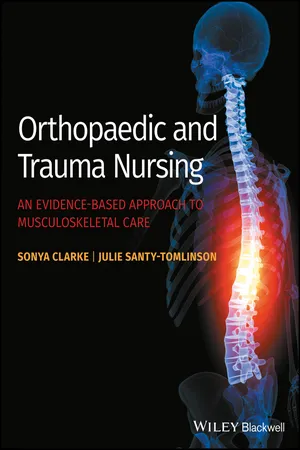Historical perspectives
In an early textbook, Mary Powell (1951) wrote of the general principles of orthopaedic nursing, which embodied the principles of rest balanced with movement and exercise, treatment of the patient as a whole, optimum positioning for joints using splinting and traction, relief of pain and the provision of the best conditions for recovery and healing. This encompassed pre-operative and post-surgical care, trauma care and rehabilitation. With a focus on the nurse–patient relationship and team work, many parallels can be drawn with orthopaedic and trauma nursing today. The book was based on her many experiences up to that time of inter- and post-war orthopaedic care and what she had learnt from the teachings of Dame Agnes Hunt. Although care must have been provided to patients with musculoskeletal conditions and injuries in earlier times, it is often said that orthopaedic nursing’s history – particularly in the UK – began with Dame Agnes Hunt in Shropshire, England in the early decades of the 20th century. Widely associated with the early development of orthopaedic nursing, Agnes Hunt took an approach to the care of individuals with musculoskeletal problems and disability that focused on the importance of rest, fresh air and good nutrition in ensuring the proper development and recovery of diseased, injured and deformed bone, joints and soft tissue. Many common musculoskeletal diseases of that time such as tuberculosis and poliomyelitis were largely eradicated in developed countries during the twentieth century and this has resulted in important and far reaching change in the priorities for orthopaedic and trauma care since that time. Even so, this history remains pertinent to the way in which care is provided today.
The early literature relating to musculoskeletal care focused on the practice of many weeks and months of enforced rest, while the current focus is on early mobilisation and avoiding inactivity. Although much is very different in the second decade of the 21st century, there are some principles of early 20th century care that remain relevant – in particular the need for what Mary Powell (1951) would have called an ‘orthopaedic conscience’ (which she later renamed the ‘orthopaedic eye’) – a special ‘sense’ or consciousness of how movement, position, posture and comfort is central to both the assessment and care of the orthopaedic patient in modern health care. This is largely based on the practitioner’s experience of working with patients. This is reflected in the way in which skilled and experienced orthopaedic and trauma practitioners are able, for example, to recognise nursing needs by instinctively observing the way in which people move or hold themselves. Skilled orthopaedic practitioners, for example, understand how gentle and minimal repositioning of a limb or supporting it with a pillow can improve comfort and support healing and recovery. Such observation and subsequent intervention still demonstrate how nurses make judgments about the needs of patients and formulate decisions about care based on clinical information derived from a variety of sources including, but not exclusively, evidence (Thompson and Dowding 2002).
As a specific entity, orthopaedic nursing has parallels with the development of orthopaedic and trauma surgery and famous surgeons such as Hugh Owen Thomas and Robert Jones. Their efforts led to the inception of orthopaedic surgery in the 1940s as part of the development of the National Health Service (NHS) in the United Kingdom as well as the development of orthopaedic and trauma services around the world. Even so, orthopaedic care has been provided for as long as the musculoskeletal system has been prone to disease and injury, although this previously took place under the auspices of bone setters, barber surgeons and other ‘informal’ carers. Trauma nursing is most often evident in nursing stories from war such as those surrounding the Crimean War and the role played by both Florence Nightingale and Mary Seacole. The care of patients sustaining musculoskeletal trauma has often made strides forward during times of conflict, war, great societal change and disaster whilst the development of elective surgery has been driven by a desire to improve lives by, for example, ameliorating the pain and disability of osteoarthritis and other chronic conditions.
At the beginning of the 20th century a number of specialist orthopaedic hospitals sprang up in the UK. This led to the rapid creation of a network of centres, often in rural or suburban locations, focused on the specialist care of patients and the education of practitioners in the principles and specifics of musculoskeletal care. These organisations also became early developers of the evidence base for orthopaedic care. As services have become more centralised, a number of these hospitals have closed and been integrated into acute urban hospital centres. Those remaining specialist hospitals continue to develop the specialist knowledge for musculoskeletal care alongside emergency departments and acute, outpatient and community units.
As the 20th century progressed musculoskeletal care began to evolve into two related entities – those of elective care and of musculoskeletal trauma care. Elective orthopaedic surgery involves procedures that are planned in advance and are designed to treat or manage known conditions which are causing pain and/or disability. This often includes surgery for arthropathies such as osteo- and rheumatoid arthritis and might also involve surgery to further manage the effects of trauma once initial recovery and healing has taken place. This might include surgery to correct deformity or the removal of ‘metal work.’ Patients with arthropathies such as rheumatoid arthritis are often cared for in specialist centres where the focus is on medical management and rehabilitation rather than on surgery. These patients might, however, be referred for elective surgery when this is thought to be of potential benefit.
Tr...
